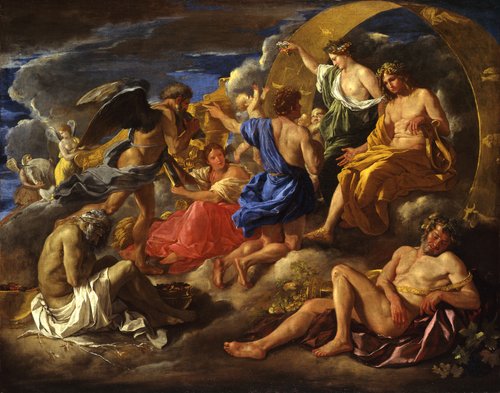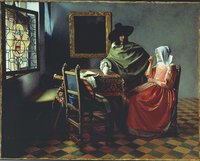Die komplexe, relativ seltene Darstellung hat ihre Quelle in den Metamorphosen des Ovid (II, 19-48), die durch die Übersetzung und Überarbeitung von Giovanni Andrea dell`Anguillara (Le Metamorfosi di Ovidio, 1561) zugänglich waren. Der junge Phaëton kniet vor seinem Vater, dem Sonnengott Helios (auch mit Apoll identifiziert) um ihn zu bitten, den links in Hintergrund von den Horen vorbereiteten Sonnenwagen für einen Tag herzuleihen. Ein Wunsch, der tödliche Konsequenzen für den Jungen haben sollte. Helios, unter einem Bogen von Tierkreiszeichen sitzend, ist mit der Leier Apolls gekennzeichnet, Personifikationen der Jahreszeiten umgeben ihn: Zu seiner rechten Seite verkörpert eine junge von Blumen gekrönte Dame den Frühling und reicht Blumen an einigen Amoretten; hinter Phaëton sitzt der Sommer als Frau mit einem Spiegel in den Händen; im Vordergrund liegt rechts der schlafende, betrunkene Herbst neben einer Vase voller Trauben; links die sitzende, frierende Figur des Winters, zu dessen Füßen zwei mit glühender Kohle gefüllten Kohlenbecken ein wenig Abwehr gegen die Kälte leisten. Hinter dem Winter schließlich läuft die geflügelte Darstellung der Zeit, der Titan Chronos, der allerfressende Vater von Zeus. Der greise Gigant isst - wie von Alessandro Della Latta anerkannt - einen Stein: Es war ein Trick seiner Frau Rea, die vermeiden wollte, dass auch Zeus wie der übrige Nachwuchs von Chronos gefressen wurde, und das Neugeborene durch einen Stein ersetze. Dieses berühmte Gemälde wurde durch Nicolas Pérelle vor 1666 und später auch von dem Florentiner Cesare Fantetti seitenverkehrt gestochen. Höchstwahrscheinlich handelte es sich zudem um jenes Werk, das zwecks Begutachtung vom Maler und Kunsthändler Jean-Michel Picart in der Académie royale de peinture et de sculpture im Jahr 1674 vorgestellt wurde. Es ist ebenso möglich, wenngleich nicht sicher, dass unser Bild mit dem als „Jahreszeiten“ bezeichneten Gemälde identisch ist, das im Inventar des Sammlers Michel Passart 1684 aufgelistet wird. Seit 1773 gehörte die mythologische Darstellung zur Sammlung Friedrichs II., und wird in Oesterreichs Beschreibung des Neuen Palais in Potsdam aufgeführt. In der Vergangenheit wurde das Werk zu spät datiert (1633-38), doch scheint es unmittelbar vor 1630 ausgeführt worden zu sein. Es gibt kompositorische Elemente, die z.B. an Poussins Parnass (Madrid, Museo del Prado, 1629: die Figur des Apoll) erinnern oder an dessen Tod des Germanicus von 1628 (Minneapolis, Institute of Arts); letzteres gleicht dem vorliegenden Werk auch in der Farbgebung. Die neovenezianisch orientierte Palette und die antiken Inspirationen schaffen eine Verbindung zu Poussins mythologischen Szenen der späten 20er-Jahre, bei denen es sich um freie Adaptionen von Werken Tizians handelt, besonders auffällig beispielsweise zu dem Midas und Bacchus der Alten Pinakothek, München. In dem herrlichen, damals in der Sammlung des Kardinals Mazarin, jetzt im Institute of Arts in Detroit befindlichen, Gemälde Diana und Endymion finden sich erhebliche Ähnlichkeiten, dazu ein ähnliches Format - identisch in der Höhe, aber 15 Zentimeter breiter -, was eine Wirkung als Pendant des vorliegenden Bildes nicht ausschließt. Auch thematisch gesehen wäre eine Verbindung mit dem Helios und Phaeton nicht auszuschließen, etwa, wenn man das Motiv des von vier Pferden gezogenen Wagens von Apoll/Helios im Hintergrund oben betrachtet. Ebenfalls in Poussins römischen Jahren, doch ein wenig später, wiederholte der Künstler den Wagen des Apoll/Helios, abermals vom Zodiakus umgeben, hoch am Himmel in seinem Reich der Flora (Dresden, Gemäldegalerie Alte Meister), einem Auftrag des Marquis Valguarnera von 1631. Die Figur des Apoll im Berliner Bild wiederholt sich im Parnass des Prado und in der Figur des Crocus im Dresdener Reich der Flora, einem Meisterwerk der ersten römischen Jahre I 200 Meisterwerke der europäischen Malerei - Gemäldegalerie Berlin, 2019 :::::::::::::: This intricate, relatively uncommon pictorial theme has its source in the Metamorphoses of Ovid (II:19–48), which was made accessible in Italian through a translation and reworking by Giovanni Andrea dell’Anguillara (Le Metamorfosi di Ovidio, 1561). The young Phaeton kneels before his father, the sun god Helios (who is also identified with Apollo) and requests permission to borrow the sun chariot, being prepared by the Horae and visible here in the left-hand background, for one day. This desire will have fatal consequences for the youth. Helios, who is seated beneath an arch decorated with zodiacal symbols, is identified by Apollo’s lyre, and surrounded by personifications of the seasons: the young woman on his right, crowned with flowers, and shown proffering flowers to a number of cupids, embodies Springtime; seated behind Phaeton is Summer, who takes the form of a woman holding a mirror in her hands; reclining on the right foreground next to a vase filled with grapes is the sleeping, inebriated Autumn; and visible to his left is the seated, freezing figure of Winter, at whose feet a pair of braziers, filled with glowing coals, provide a minimal defence against the cold. Striding along behind Winter, finally, is the winged personification of Time, the Titan Chronos, the all-devouring father of Zeus. The aged giant eats – as recognized by Alessandro Della Latta – a stone: this was a trick of his wife Rea, who wanted to avoid having Zeus devoured by Chronos alongside her other offspring, and who therefore replaced the newborn with this object. This famous painting was engraved by Nicolas Pérelle before 1666, and later by the Florentine artist Cesare Fantetti as well, this time laterally reversed. In all likelihood, moreover, this was the same work that was presented by the painter and art dealer Jean-Michel Picart to the Académie royale de peinture et de sculpture in 1674 for their appraisal. It also seems possible, despite some uncertainty that the Berlin picture is identical with the painting referred to as “Seasons” in the inventory of the collector Michel Passart in 1684. Beginning in 1773, this mythological composition was part of the collection of Frederick the Great, and was included in Oesterreich’s description of the Neues Palais in Potsdam. In the past, this work has been given a date that seems too late (1633–38), for it seems to have been executed just before 1630. Certain compositional elements are reminiscent for example of Poussin’s Parnassus (Madrid, Museo del Prado, 1629: the figure of Apollo), or of his Death of Germanicus of 1628 (Minneapolis, Institute of Arts); the latter painting is also close to the present picture with regard to the colour scheme. The colour palette, with its neo-Venetian orientation, and the inspiration from antiquity, represents a connection to Poussin’s mythological scenes from the late 1620s, which involve free adaptations of works by Titian, an especially striking example being the Midas and Bacchus in the Alte Pinakothek in Munich. Detectable in the marvellous painting Diana and Endymion, formerly in the collection of Cardinal Mazarin and now in the Institute of Arts in Detroit, are significant similarities, and these include the format (identical in height, but 15 cm wider), suggesting the possibility that it functioned originally as a pendant to the present picture. Thematically as well, a connection with Helios and Phaeton cannot be excluded, particularly when we consider the motif of the chariot of Apollo/Helios in the background, a quadriga drawn by four horses. Also in the Roman years, albeit slightly later, Poussin repeated the chariot of Apollo/Helios, once again surrounded by zodiacal symbols, and set high up in the heavens in his Empire of Flora (Dresden, Gemäldegalerie Alte Meister), commissioned by the Marquis of Valguarnera in 1631. The figure of Apollo in the Berlin picture is repeated in the Parnassus in the Prado and in the figure of Crocus in the Dresden Empire of Flora, a masterwork from the first Roman years.| 200 Masterpieces of European Painting - Gemäldegalerie Berlin, 2019
de

